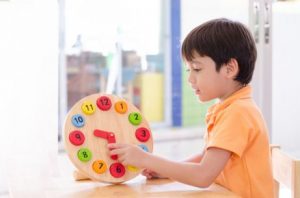Games That Help Children Learn How to Tell Time

Learning how to tell time isn’t easy for children. It requires the understanding of mathematical concepts such as how to add and subtract numbers by five, quarter-hours and half-hours.
Playing is the best way for children to understand the movement of the hands on a clock. If we use games as tools, it will be easier for them to learn to tell time.
To learn how to tell time, it’s first important that children know how to count at least up to 60, as well as add and subtract by five. We should always make sure to provide them with learning activities that are within their capabilities.
We must also remember how strange it was for us when we had to learn how to tell time, and find out that on a clock, the number one meant five, or that four meant 20, etc. But by using games, we can make this learning experience fun for little ones.
Games to learn how to tell time
With materials that we have at home or in the classroom, we can make clocks for children to play with. Children can manipulate the hands and learn about the concept of time through games.
The day on the clock
For littlest ones, learning the concept of time and its relationship with daily activities is the first step. In a circle, serving as a clock, illustrated activities are placed instead of numbers.
Waking up, bathing, going to class or doing homework will replace the spaces where the hours usually are. Children will move the hands accordingly each time they do an activity.

Hours and minutes
With two circles of different sizes, we can teach children to group the minutes by five, and tell time. For this, we can cut two circles in plastic plates, with cardboard or whatever material we have at hand.
Write the numbers 1-60 in the big circle while making the multiples of five larger than the rest. In the little circle, we’ll draw the hours, making sure the numbers of the two circles coincide (one with five, two with ten, etc.).
Make some hands and place them with a support so that they can turn. By visualizing the large circle, children can relate the concepts of hours and minutes. We’ll tell them a time and they’ll have to move the hands to illustrate it. Eventually, we can remove the big circle and test what has been learned.
Time Bingo
We make cards that mimic those of bingo, but instead of numbers, each frame will have a different time in digital format (e.g. 2:15).
We can make a cardboard clock with turning hands, and in it, we’ll put different times. The children will have to recognize them and mark on their cardboard if they have the right one. As in bingo, whoever completes a vertical line or a horizontal line wins.
Digital games
Without a doubt, children today feel comfortable learning with digital devices. Laptops, tablets, and smartphones are as natural to them as a chalkboard and chalk are to grandparents.
There are a lot of virtual games to help children learn how to tell time.
The clock
The Spanish Ministry of Education has made a game available to learn how to tell time. By clicking on an illustration, the children will find explanations to help them understand the concept of telling time.
Besides that, there are also activities and games to help them retain the knowledge acquired. It’s a friendly application that guides children through the steps they should take.

What time is it?
This virtual game was created by Junta de Castilla y León. It’s a fairly simple application where a specific time is verbally given to children.
In the image of an analog clock, children must place the hands on an indicated time. They have 90 seconds to place six proposed times.
The hours on the clock
In this game, from the government of the Canary Islands, children find simple information and games to learn how to tell time. It starts off with explanations about the different types of clocks.
And it continues with explanations on the operation of the hands, the hours and minutes. Afterward, children have the opportunity to test their knowledge with various games and activities.
All cited sources were thoroughly reviewed by our team to ensure their quality, reliability, currency, and validity. The bibliography of this article was considered reliable and of academic or scientific accuracy.
- Ortiz, P. (2014). Proyecto Tic Toc diseño de una herramienta para enseñar a leer la hora a niños con dislexia (Bachelor’s thesis, Quito: USFQ, 2014). https://repositorio.usfq.edu.ec/handle/23000/5306
This text is provided for informational purposes only and does not replace consultation with a professional. If in doubt, consult your specialist.
